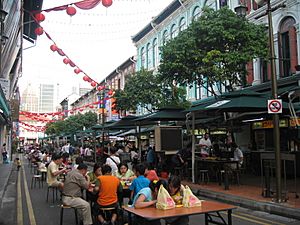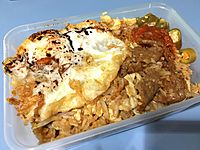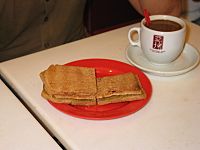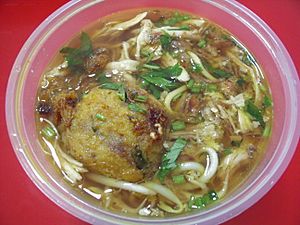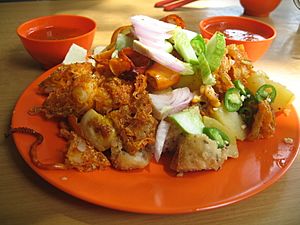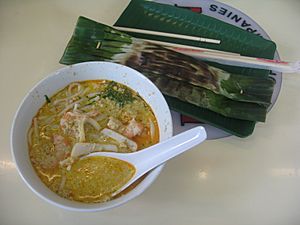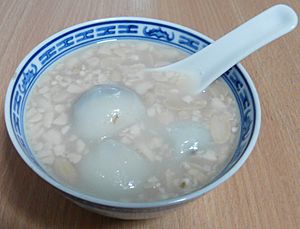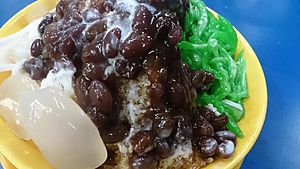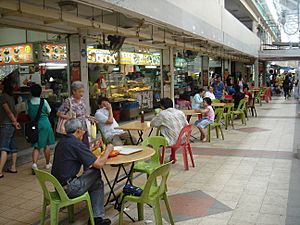Singaporean cuisine facts for kids
Singaporean cuisine is a mix of different food traditions from the many ethnic groups living in Singapore. Over hundreds of years, Singapore's food has changed and grown because of its history, economy, and social life as a busy city-state.
The food is influenced by Malay, Chinese, and Indian cooking styles. You can also find tastes from Indonesian, Peranakan, and Western foods, especially English and Portuguese styles. Even foods from nearby countries like Japan, Korea, and Thailand have added to Singapore's unique dishes.
In Singapore, food is super important to the country's identity. It helps bring people together. Many Singaporeans love talking about food, and eating is a favorite activity! Different religions have their own food rules. For example, Muslims don't eat pork, and Hindus don't eat beef. There are also many vegetarians and vegans. People from different groups often eat together, making sure to choose food that everyone can enjoy.
Besides local Singaporean food, you can find restaurants from all over the world in Singapore.
Contents
History of Singaporean Food
Singapore became a British port in 1819. Since then, its food has been shaped by many cultures. This is because Singapore is a major international shipping hub. It sits between the Pacific and Indian oceans, like a peninsula and an island. This location has always brought different cultures and trades together. Countries like Indonesia, Thailand, China, the Philippines, Malaysia, and India are all nearby. This closeness to various Asian countries makes Singapore's food and culture very diverse.
Singapore's culture is a rich mix of influences from many continents and countries. This makes Singaporean food truly special. Its colonial past also played a role. Singapore was a British colony for a long time. It was also occupied by Imperial Japan during World War II.
Some Singaporean dishes, like laksa, biryani, and betel quid, might even be older than 1819. But we don't know exactly when they arrived. Early immigrants often made these dishes at home. Over time, dishes like Fish head curry, Kaya toast, and Hainanese chicken rice were created. These became popular by adapting older recipes to local ingredients and tastes. Today, they are key parts of Singaporean cooking.
Hawker Centres: Eating Together
A big part of Singapore's food scene happens at hawker centres. These places started around the mid-1800s as street food stalls. Vendors would sell cheap, quick meals from pushcarts or bicycles. They served workers and people who didn't cook at home. However, these street stalls were not very clean. They lacked proper waste disposal and fresh water.
Starting in the 1960s, the Singapore government began to improve things. They moved street vendors into cleaner, permanent spots. They built wet markets and hawker centres all over the country.
Today, Singaporeans often eat at hawker centres, coffee shops, or food courts. These are popular because they are convenient, offer many choices, and are affordable. Hawker centres are everywhere and usually have dozens of stalls in one place. Each stall often specializes in certain dishes. Famous hawker centres include Telok Ayer Market, Maxwell Food Center, and Lau Pa Sat. Coffee shops are like food courts but without air conditioning. You can often find them at the bottom of HDB apartment buildings.
Hawker centres are great places to try many different cultural foods in one spot. They truly show what Singaporean food culture is all about. Popular dishes you can find include kaya toast, chilli crab, fish head curry, laksa, roti prata, and Hainanese chicken rice. Hainanese chicken rice is even thought of as one of Singapore's national dishes!
In 2016, two street food stalls, Hong Kong Soya Sauce Chicken Rice and Noodle and Hill Street Tai Hwa Pork Noodle, received a Michelin star. This was a first for street food anywhere in the world! One of them also became known for the world's "cheapest Michelin-starred meal."
In 2020, Singapore's hawker culture was added to UNESCO's list of important cultural heritage. UNESCO called hawker centres "community dining rooms." They are places where people from all walks of life gather to share meals.
Food Culture in Singapore

A common greeting for many Singaporean Chinese people is "Have you eaten?" This shows how much Singaporeans value food and meals. Since Singapore is a multicultural country, people have different diets and food rules. For example, Muslims and Hindus have specific dietary restrictions.
Singapore's food is also shaped by many regions, religions, and celebrations. During the Lunar New Year, people eat nian gao. This sticky rice cake comes from China and is a traditional New Year food. Singaporean food is like an extension of Malay cooking, but with strong influences from Chinese, Indian, Arab, and British traditions. All these influences have helped make Singapore one of the world's most important trading ports.
Singaporean Food Around the World
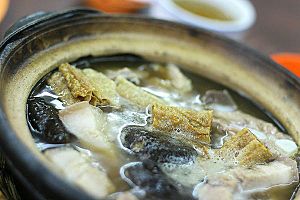
Singaporean food is a big draw for tourists. Some dishes have become famous internationally. In 2011, four Singaporean dishes were on CNN International's list of 'World's 50 Most Delicious Foods.' These were Hainanese chicken rice (13th), chili crab (29th), Katong Laksa (44th), and roti prata (45th).
Famous chefs and TV personalities have also helped make Singaporean food known. Anthony Bourdain showed local hawker centre food on his show No Reservations. He featured places like Tian Tian Chicken Rice. He even talked about wanting to bring Singaporean dishes to his food hall in New York City.
Gordon Ramsay took part in a 'Hawker Heroes Challenge' in Singapore in 2013. He competed against local hawkers. While his chili crab was voted the best, he lost on two other dishes. He was amazed by the hawkers and how they welcomed him into their kitchens.
YouTube star Mike Chen, known as Strictly Dumpling, has made many videos about Singaporean food. He highlighted street food, hawker centres, and buffets. His videos have been watched over 17 million times!
The Singapore Tourism Board promotes Singaporean food as a tourist attraction. The Singapore Food Festival happens every July. It's a big celebration of Singapore's amazing food.
Types of Food and Popular Dishes
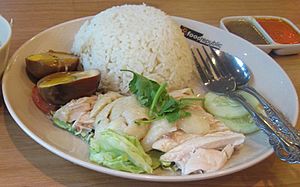
Singaporean food can be put into six main groups: meat, seafood, rice, noodles, desserts, and snacks. Singapore is especially famous for its seafood. Chili crab and black pepper crab are two must-try dishes. Another favorite is sambal stingray.
In the meat group, Hainanese chicken rice is the most popular. It's rice cooked with chicken fat, served with boiled chicken, and a special chili sauce.
Three noodle dishes are very popular. "Fried Hokkien mee" has fried egg noodles with prawns, pork, and gravy. "Nyonya laksa" is rice noodles in a creamy coconut prawn broth. "Char Kuey Teow" is stir-fried rice noodles with prawns, Chinese sausage, and cockles.
For dessert, tau-suan is common. It's a sweet soup made from split mung beans, often eaten with Youtiao (fried dough).
For snacks, kaya toast is a classic. It's toasted bread with kaya (a sweet coconut and egg jam) and butter. This is often eaten for breakfast with coffee and soft-boiled eggs.
Chinese Dishes
The Chinese dishes in Singapore came from early immigrants from southern China. They adapted their recipes to local ingredients and added influences from Malay and Indian cooking. Many dish names come from Chinese dialects, especially Hokkien. This is why you might see different spellings for the same dish, like bak kut teh or bah kut teh.
Here are some popular Chinese dishes:
- Bak kut teh: Pork rib soup with Chinese herbs and spices.
- Bak Chor Mee: Egg noodles with minced pork, mushrooms, and meatballs, served dry or in soup.
- Chai tow kway (Carrot Cake): Steamed radish cakes stir-fried with garlic, egg, and preserved radish. It can be black (with dark soy sauce) or white (like an omelette).
- Char kway teow: Thick, flat rice noodles stir-fried in dark soy sauce with shrimp, eggs, and other ingredients.
- Hainanese chicken rice: Chicken served with rice cooked in chicken broth. It's considered Singapore's national dish.
- Hokkien mee: Egg noodles and rice noodles stir-fried with egg, pork, prawns, and squid.
- Kaya toast: Toasted bread with sweet coconut and egg jam. A classic breakfast.
- Popiah: A fresh spring roll filled with stewed turnip, sausage, shrimp, and lettuce.
- Yong Tau Foo: A dish with various items like tofu filled with meat or fish paste, fish balls, and vegetables.
-
Kaya toast, a traditional breakfast dish
Malay Dishes
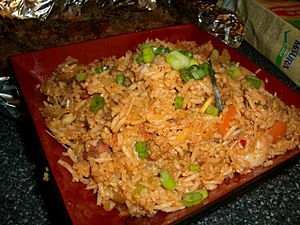
Singaporean Malay dishes are influenced by food from Malaysia, Sumatra, Java, and the Riau Islands. They are adapted to local tastes. Most Malays in Singapore have roots in Indonesia or Malaysia. This gives Singaporean Malay cuisine unique influences, especially from Minang food. Spices and coconut milk are common. Chinese ingredients like tofu puffs (taupok) are also used. Since almost all Malays are Muslims, pork is not used.
Some popular Malay dishes include:
- Acar: Pickled vegetables or fruits with chili and peanuts.
- Curry puff: A flaky pastry usually filled with curry chicken and potato.
- Nasi goreng: Steamed rice stir-fried with eggs, vegetables, and meat.
- Nasi Padang: Steamed white rice served with many pre-cooked dishes on small plates.
- Otak-otak/otah: Spicy fish cake grilled in a banana leaf.
- Satay: Grilled meat on skewers, served with a spicy peanut sauce.
- Sayur lodeh: A mix of vegetables cooked in coconut milk.
- Soto: A soup with meat and vegetables.
Indian Dishes

Indian food in Singapore has influences from many cultures, including both North and South India.
Here are some common Indian dishes:
- Dosa: A thin pancake made from rice and lentils. Often served with spiced potatoes.
- Murtabak: An Indian-Muslim dish. It's folded dough filled with spiced minced meat, onions, and egg. Served with curry.
- Naan: An Indian flatbread baked in an oven.
- Roti prata: A local version of the Indian paratha. It's a fried bread pancake, crispy outside and soft inside. It's often eaten for breakfast or supper with curry or sugar.
- Soup kambing: A spicy mutton soup.
- Soup tulang merah: Mutton or beef leg bones stewed in a sweet and spicy red soup. This dish is considered a Singaporean invention.
- Tandoori chicken: Chicken marinated in spices and yogurt, cooked in a clay oven.
Cross-Cultural Dishes
These dishes are a true mix of different ethnic foods in Singapore.
- Ayam buah keluak: A Peranakan dish of chicken stewed with spices and black nuts.
- Biryani or Nasi Briyani: A popular mixed rice dish found in Malay or Indian food stalls.
- Cereal prawns: Stir-fried prawns with sweetened cereal.
- Fish head curry: A dish created by Singapore's Malayali (Indian) community. It's a red snapper head stewed in curry with coconut milk and tamarind juice. Served with rice or bread.
- Katong Laksa: Thick rice noodles in a creamy coconut curry gravy with prawn and egg.
- Mee rebus: Egg noodles with a spicy, slightly sweet curry-like gravy made from sweet potatoes and spices.
- Mee siam: A dish of thin rice vermicelli noodles.
- Mee goreng: Yellow egg noodles stir-fried with ghee, tomato sauce, chili, eggs, and various meats.
- Rojak: A fruit and vegetable salad with Indian and Malay/Indonesian influences.
- Satay bee hoon: Rice noodles served with cuttlefish, tofu puffs, cockles, and water spinach in satay sauce.
- "Western Food": In hawker centres, you can find "Singapore-style" chicken chop or pork chop. These are often served with fries, coleslaw, and baked beans. This style came from Hainanese immigrants who worked as cooks for Western families.
Seafood Dishes
Singaporeans love seafood like fish, squid (sotong), stingray, crab, lobster, and clams.
Popular seafood dishes include:
- Black pepper crab: Hard shell crabs cooked in a black pepper sauce. Salted Egg crab is also popular.
- Chilli crab: Hard shell crabs cooked in a chili sauce, often served with man tou (deep-fried buns) for dipping.
- Oyster omelette: An omelette with fresh oysters, tapioca starch, and eggs.
- Sambal stingray: Stingray covered in sambal (chili paste) and served on a banana leaf.
Fruits
Many tropical fruits are available all year. The most famous is the durian, called the "King of Fruits." It has a strong smell and creamy yellow flesh inside its spiky shell. Because of its strong smell, durians are not allowed on public transport, in elevators, or in some hotels.
Other popular tropical fruits include mangosteen, jackfruit, longan, lychee, rambutan, soursop, pineapple, and mango. Some of these fruits are also used in desserts, sweet-and-sour dishes, and salads like rojak.
Desserts
Singaporean desserts have a rich history. A typical hawker centre dessert stall will have many choices:
- Bubur cha cha: A dish with sago, sweet potatoes, yams, bananas, and black-eyed peas cooked in coconut milk. Served hot or cold.
- Chendol: Green pandan jelly strips with coconut milk and palm sugar syrup over shaved ice. You can add red beans, sweet corn, or even durian.
- Cheng tng: A light, refreshing soup with longan, barley, and lotus seeds in a sweet syrup. Served hot or cold.
- Ice kacang: A mound of shaved ice over jelly, red beans, and corn. Topped with colorful syrups and evaporated milk.
- Kuih or kueh: Small cakes or coconut milk-based desserts. They come in many flavors, often with fruit like durian or banana.
- Kueh lapis: A rich, multi-layered cake with many egg whites and prunes.
- Orh-nee: A Teochew dish of taro (yam) paste, coconut paste, and ginkgo nuts.
- Tau suan: Mung beans in jelly, served hot with fried dough crullers.
Ice Cream Sandwich
Ice cream sandwiches made with wafers are a popular treat sold by street vendors. These carts offer flavors like vanilla, chocolate, strawberry, coffee, sweet corn, coconut, and durian. While you can get ice cream in cups or cones, it's very popular to have it on a slice of bread or between wafers. The ice cream is sliced from a block and placed on a large, often colorful slice of bread. This bread can be white or a slightly sweet, multicolored bread. A sandwich usually costs around S$1.
Drinks and Beverages
Popular Singaporean drinks include:
- Bandung: Rose syrup mixed with evaporated milk.
- Chin chow drink: Sweet drink made from grass jelly.
- Kopi: The local coffee in Singapore. It has its own special lingo:
- Kopi: Coffee with sugar and condensed milk.
- Kopi-O: Coffee with sugar.
- Kopi-O-Kosong: Coffee without sugar or evaporated milk.
- Kopi-C: Coffee with sugar and evaporated milk.
- Kopi-Peng: Iced coffee with sugar and condensed milk.
- Kopi-Siew-Dai: Coffee with less sugar and condensed milk.
- Kopi-Gao: Coffee with extra thick, concentrated coffee.
- Lemon barley drink
- Water chestnut drink
- Horlicks: Malt milk drink. Horlicks Dinosaur has extra Horlicks powder on top.
- Milo: Chocolate/malt milk drink. Milo Dinosaur has extra Milo powder on top.
- Sugarcane juice: Freshly blended from sugarcane stalks.
- Teh halia tarik: Ginger tea with "pulled" milk.
- Singapore Sling: A cocktail invented at Singapore's Raffles Hotel.
Singaporean Dishes Not Common in Singapore
Some dishes with "Singapore" in their name are actually not found in Singapore!
- Singapore style noodles (Chinese: 星州炒米粉; pinyin: xīng zhōu chǎo mí fěn): An American Chinese dish with fried rice vermicelli and yellow curry powder. This dish is not found in Singapore. A similar local dish is fried bee hoon (thin rice noodles).
- Singapore fried kway tiao (Chinese: 星州炒粿条; pinyin: xīng zhōu chǎo guǒ tiáo): A dish with fried thick, flat rice noodles and dark soy sauce. This is common in some Chinese restaurants in Canada and the US, but it's not a Singaporean dish. The closest local dish is char kway teow.
|
See also
 In Spanish: Gastronomía de Singapur para niños
In Spanish: Gastronomía de Singapur para niños


